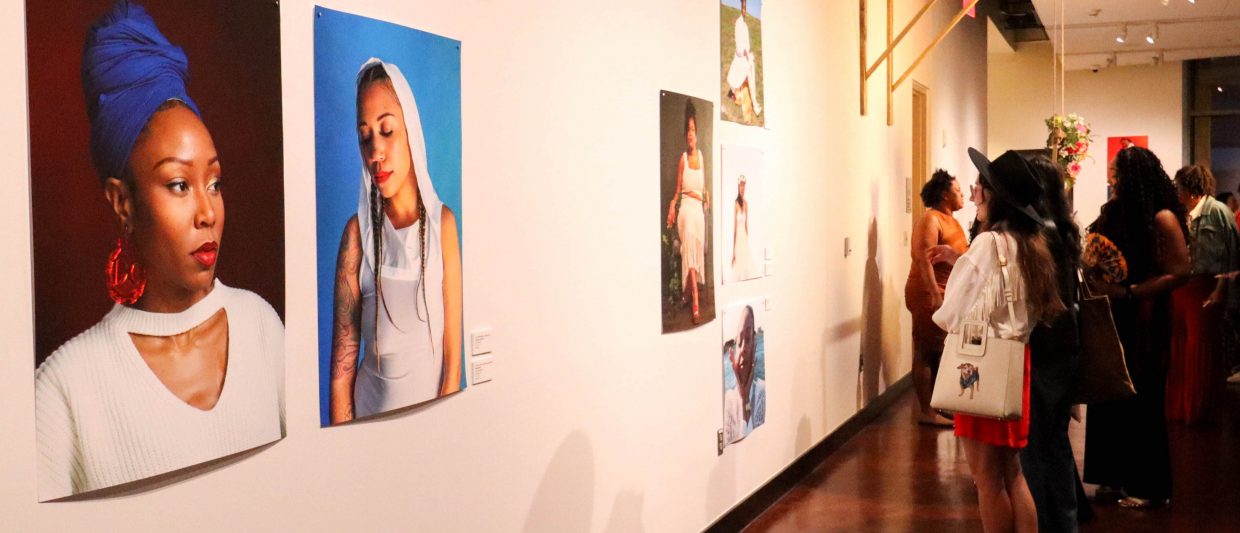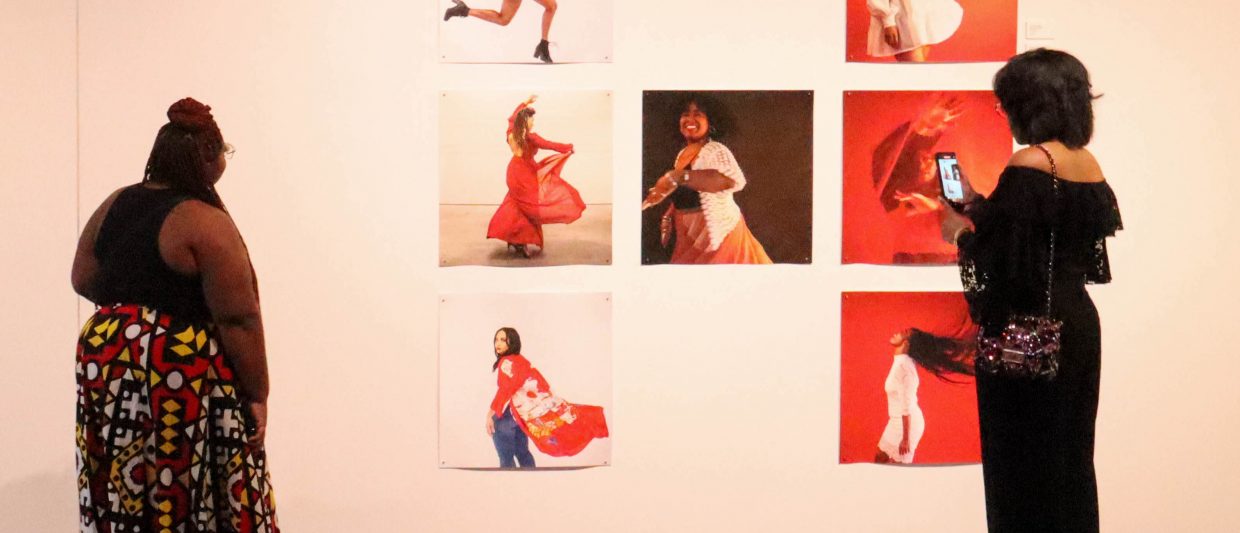‘Black Girls Don’t Wear Red Lipstick’ Exhibit Challenges Beauty Standards
By Michelle Lavergne
Reporting Texas

Patrons browse portraits featured at the “Black Girls Don’t Wear Red Lipstick” exhibit at the Austin Central Library. Michelle Lavergne/Reporting Texas
Portraits of Black women donning various shades of red lipstick line the walls of the art gallery inside the Austin Central Library.
The artist responsible for the photos, Leta Harrison, is the first female Black photographer to have her photos featured at the library’s art gallery.
“I’m still processing what that feels like because it’s a big undertaking,” Harrison said. “I have an overwhelming sense of joy and I feel like I have a big responsibility to other Black women and other Black women creatives.”
The exhibit showcases 42 photos of Black women in varying poses. A red vanity table with a mirror is displayed at a corner of the gallery.
“We placed (the vanity) there so women could see themselves as they were,” Harrison said.
The significance of red lipstick has evolved throughout history, with the color becoming a visual statement of prestige, glamor, sexual liberation and defiance for white women, says Lisa B. Thompson, professor of African and African Diaspora Studies at the University of Texas at Austin.
In the early 20th century, white women fighting for the right to vote often wore the bold color while marching down the streets of New York, and the color became synonymous with the women’s suffrage movement.
“Black women were not included the way they should have been in terms of having conversations about suffrage,” Thompson said. “Black women were just not considered equal to white women.”
Traditionally Black women have been discouraged from wearing red lipstick, were taught that red doesn’t look good with dark skin, and told that it signifies that the wearer is sexually promiscuous, Thompson said.
“The effect of it is to make us feel ashamed, to make us feel ugly and to make us feel less than,” Thompson added.
Harrison, 42, started taking photographs as a hobby in 2017. In 2019 she moved from Washington D.C. to Austin. Harrison, who previously worked in customer service, started a job as a project manager with the Downtown Austin Alliance in 2023.
For the photography exhibit, Harrison photographed women in Austin, Houston and Washington D.C. One of her subjects is Sharon Mays, who is a chief of staff at the Austin City Council.
“When I heard about her first Black Girls Don’t Wear Red Lipstick photo series, it resonated with me so much that I wore red lipstick to every City Council meeting for a month,” Mays said.
“Red is my favorite color, so I spent years searching for the perfect shade of red lipstick and nail polish. I used to wear red lipstick regularly but I eventually stopped because it always seemed to draw so much attention, often negative,” Mays said.

Patrons browse the portraits featured at the “Black Girls Don’t Wear Red Lipstick” exhibit held at the Austin Central Library. Michelle Lavergne/Reporting Texas
Harrison drew inspiration from a symposium about resistance fashion and self-expression by Houston artist Kam Franklin during Black History Month at East Austin’s George Washington Carver Museum in 2023. During the symposium, Harrison was moved by how Franklin shared her experiences of being told to be modest as a little girl and that Black girls don’t wear red lipstick, Harrison said.
“My personal journey with wearing red lipstick is that I had an ex-partner who would make fun of me quite often for wearing red lipstick and making me feel insecure for being a little bit more bright,” Harrison said.
Harrison’s exhibit had its first run at the Carver museum from April until July 2023. Her most impactful memory from this was of a little girl who made a scrapbook of the exhibit.
“I thought it was pretty amazing to be able to have that kind of reach with such a young person,” Harrison said.
Carmalita McKinnis-Williams, Austin public library equity inclusion manager, said the exhibit at the Carver Museum was instrumental in bringing the exhibit to the library.
McKinnis-Williams emphasized it is important that photos of Black women are being given a place of prominence in Austin, a city whose Black population has seen sluggish growth while its total population has exploded. Black people comprise 7.9% of Austin’s almost one million residents.
Exhibit co-curator Keyheira Keys hopes the photos help Black female Austinites feel celebrated. Art can be viewed as a luxury for Black and brown communities because they don’t see themselves in the art displayed in most galleries, Keys said.
Keys wants a Black woman viewing the exhibit to know “she’s worthy to have art in her home that looks like her, that’s reflective of her, that’s just as expensive and important as any other piece of art.”